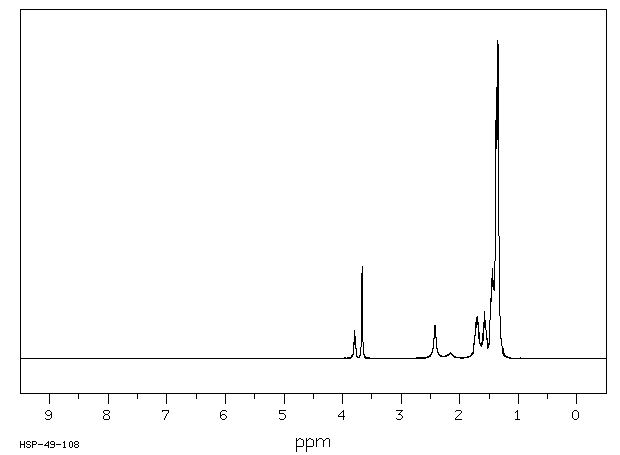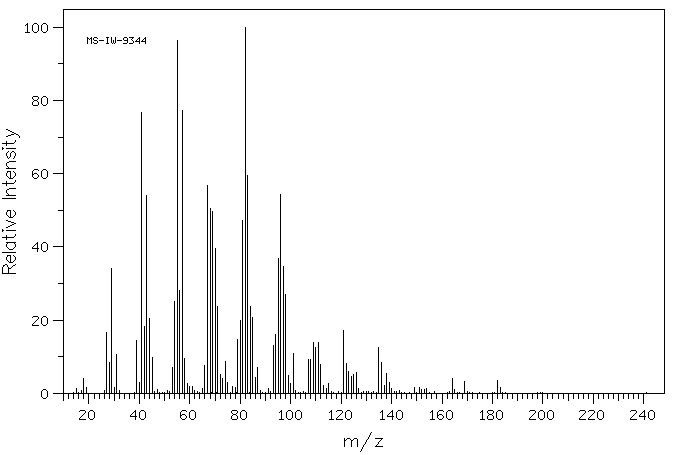1,2-环十二烷二醇 | 15199-41-4
中文名称
1,2-环十二烷二醇
中文别名
1,2-环十二烷二醇(顺反异构体混和物);1,2-环十二烷二醇(顺反异构体混合物)
英文名称
cyclododecane-1,2-diol
英文别名
1,2-dihydroxycycododecane;1,2-cyclododecanediol;1,2-cyclododecandiol;Cyclododecan-1,2-diol
CAS
15199-41-4
化学式
C12H24O2
mdl
MFCD01321150
分子量
200.321
InChiKey
HAMFVYJFVXTJCJ-UHFFFAOYSA-N
BEILSTEIN
——
EINECS
——
-
物化性质
-
计算性质
-
ADMET
-
安全信息
-
SDS
-
制备方法与用途
-
上下游信息
-
文献信息
-
表征谱图
-
同类化合物
-
相关功能分类
-
相关结构分类
物化性质
-
熔点:121.0 to 125.0 °C
计算性质
-
辛醇/水分配系数(LogP):3.4
-
重原子数:14
-
可旋转键数:0
-
环数:1.0
-
sp3杂化的碳原子比例:1.0
-
拓扑面积:40.5
-
氢给体数:2
-
氢受体数:2
安全信息
-
海关编码:2906199090
SDS
1,2-环十二烷二醇 (顺反混合物) 修改号码:6
模块 1. 化学品
产品名称: 1,2-Cyclododecanediol (cis- and trans- mixture)
修改号码: 6
模块 2. 危险性概述
GHS分类
物理性危害 未分类
健康危害 未分类
环境危害 未分类
GHS标签元素
图标或危害标志 无
信号词 无信号词
危险描述 无
防范说明 无
模块 3. 成分/组成信息
单一物质/混和物 单一物质
化学名(中文名): 1,2-环十二烷二醇 (顺反混合物)
百分比: >87.0%(GC)
CAS编码: 15199-41-4
分子式: C12H24O2
模块 4. 急救措施
吸入: 将受害者移到新鲜空气处,保持呼吸通畅,休息。若感不适请求医/就诊。
皮肤接触: 立即去除/脱掉所有被污染的衣物。用水清洗皮肤/淋浴。
若皮肤刺激或发生皮疹:求医/就诊。
眼睛接触: 用水小心清洗几分钟。如果方便,易操作,摘除隐形眼镜。继续清洗。
如果眼睛刺激:求医/就诊。
食入: 若感不适,求医/就诊。漱口。
紧急救助者的防护: 救援者需要穿戴个人防护用品,比如橡胶手套和气密性护目镜。
模块 5. 消防措施
合适的灭火剂: 干粉,泡沫,雾状水,二氧化碳
1,2-环十二烷二醇 (顺反混合物) 修改号码:6
模块 5. 消防措施
特定方法: 从上风处灭火,根据周围环境选择合适的灭火方法。
非相关人员应该撤离至安全地方。
周围一旦着火:如果安全,移去可移动容器。
消防员的特殊防护用具: 灭火时,一定要穿戴个人防护用品。
模块 6. 泄漏应急处理
个人防护措施,防护用具, 使用个人防护用品。远离溢出物/泄露处并处在上风处。
紧急措施: 泄露区应该用安全带等圈起来,控制非相关人员进入。
环保措施: 防止进入下水道。
控制和清洗的方法和材料: 清扫收集粉尘,封入密闭容器。注意切勿分散。附着物或收集物应该立即根据合适的
法律法规处置。
模块 7. 操作处置与储存
处理
技术措施: 在通风良好处进行处理。穿戴合适的防护用具。防止粉尘扩散。处理后彻底清洗双手
和脸。
注意事项: 如果粉尘或浮质产生,使用局部排气。
操作处置注意事项: 避免接触皮肤、眼睛和衣物。
贮存
储存条件: 保持容器密闭。存放于凉爽、阴暗处。
远离不相容的材料比如氧化剂存放。
包装材料: 依据法律。
模块 8. 接触控制和个体防护
工程控制: 尽可能安装封闭体系或局部排风系统,操作人员切勿直接接触。同时安装淋浴器和洗
眼器。
个人防护用品
呼吸系统防护: 防尘面具。依据当地和政府法规。
手部防护: 防护手套。
眼睛防护: 安全防护镜。如果情况需要,佩戴面具。
皮肤和身体防护: 防护服。如果情况需要,穿戴防护靴。
模块 9. 理化特性
固体
外形(20°C):
外观: 晶体-粉末
颜色: 白色类白色
气味: 无资料
pH: 无数据资料
熔点: 无资料
沸点/沸程 无资料
闪点: 无资料
爆炸特性
爆炸下限: 无资料
爆炸上限: 无资料
密度: 无资料
溶解度:
[水] 无资料
[其他溶剂] 无资料
1,2-环十二烷二醇 (顺反混合物) 修改号码:6
模块 10. 稳定性和反应性
化学稳定性: 一般情况下稳定。
危险反应的可能性: 未报道特殊反应性。
须避免接触的物质 氧化剂
危险的分解产物: 一氧化碳, 二氧化碳
模块 11. 毒理学信息
急性毒性: 无资料
对皮肤腐蚀或刺激: 无资料
对眼睛严重损害或刺激: 无资料
生殖细胞变异原性: 无资料
致癌性:
IARC = 无资料
NTP = 无资料
生殖毒性: 无资料
模块 12. 生态学信息
生态毒性:
鱼类: 无资料
甲壳类: 无资料
藻类: 无资料
残留性 / 降解性: 无资料
潜在生物累积 (BCF): 无资料
土壤中移动性
log水分配系数: 无资料
土壤吸收系数 (Koc): 无资料
亨利定律 无资料
constaNT(PaM3/mol):
模块 13. 废弃处置
如果可能,回收处理。请咨询当地管理部门。建议在可燃溶剂中溶解混合,在装有后燃和洗涤装置的化学焚烧炉中
焚烧。废弃处置时请遵守国家、地区和当地的所有法规。
模块 14. 运输信息
联合国分类: 与联合国分类标准不一致
UN编号: 未列明
模块 15. 法规信息
《危险化学品安全管理条例》(2002年1月26日国务院发布,2011年2月16日修订): 针对危险化学品的安全使用、
生产、储存、运输、装卸等方面均作了相应的规定。
1,2-环十二烷二醇 (顺反混合物) 修改号码:6
模块16 - 其他信息
N/A
模块 1. 化学品
产品名称: 1,2-Cyclododecanediol (cis- and trans- mixture)
修改号码: 6
模块 2. 危险性概述
GHS分类
物理性危害 未分类
健康危害 未分类
环境危害 未分类
GHS标签元素
图标或危害标志 无
信号词 无信号词
危险描述 无
防范说明 无
模块 3. 成分/组成信息
单一物质/混和物 单一物质
化学名(中文名): 1,2-环十二烷二醇 (顺反混合物)
百分比: >87.0%(GC)
CAS编码: 15199-41-4
分子式: C12H24O2
模块 4. 急救措施
吸入: 将受害者移到新鲜空气处,保持呼吸通畅,休息。若感不适请求医/就诊。
皮肤接触: 立即去除/脱掉所有被污染的衣物。用水清洗皮肤/淋浴。
若皮肤刺激或发生皮疹:求医/就诊。
眼睛接触: 用水小心清洗几分钟。如果方便,易操作,摘除隐形眼镜。继续清洗。
如果眼睛刺激:求医/就诊。
食入: 若感不适,求医/就诊。漱口。
紧急救助者的防护: 救援者需要穿戴个人防护用品,比如橡胶手套和气密性护目镜。
模块 5. 消防措施
合适的灭火剂: 干粉,泡沫,雾状水,二氧化碳
1,2-环十二烷二醇 (顺反混合物) 修改号码:6
模块 5. 消防措施
特定方法: 从上风处灭火,根据周围环境选择合适的灭火方法。
非相关人员应该撤离至安全地方。
周围一旦着火:如果安全,移去可移动容器。
消防员的特殊防护用具: 灭火时,一定要穿戴个人防护用品。
模块 6. 泄漏应急处理
个人防护措施,防护用具, 使用个人防护用品。远离溢出物/泄露处并处在上风处。
紧急措施: 泄露区应该用安全带等圈起来,控制非相关人员进入。
环保措施: 防止进入下水道。
控制和清洗的方法和材料: 清扫收集粉尘,封入密闭容器。注意切勿分散。附着物或收集物应该立即根据合适的
法律法规处置。
模块 7. 操作处置与储存
处理
技术措施: 在通风良好处进行处理。穿戴合适的防护用具。防止粉尘扩散。处理后彻底清洗双手
和脸。
注意事项: 如果粉尘或浮质产生,使用局部排气。
操作处置注意事项: 避免接触皮肤、眼睛和衣物。
贮存
储存条件: 保持容器密闭。存放于凉爽、阴暗处。
远离不相容的材料比如氧化剂存放。
包装材料: 依据法律。
模块 8. 接触控制和个体防护
工程控制: 尽可能安装封闭体系或局部排风系统,操作人员切勿直接接触。同时安装淋浴器和洗
眼器。
个人防护用品
呼吸系统防护: 防尘面具。依据当地和政府法规。
手部防护: 防护手套。
眼睛防护: 安全防护镜。如果情况需要,佩戴面具。
皮肤和身体防护: 防护服。如果情况需要,穿戴防护靴。
模块 9. 理化特性
固体
外形(20°C):
外观: 晶体-粉末
颜色: 白色类白色
气味: 无资料
pH: 无数据资料
熔点: 无资料
沸点/沸程 无资料
闪点: 无资料
爆炸特性
爆炸下限: 无资料
爆炸上限: 无资料
密度: 无资料
溶解度:
[水] 无资料
[其他溶剂] 无资料
1,2-环十二烷二醇 (顺反混合物) 修改号码:6
模块 10. 稳定性和反应性
化学稳定性: 一般情况下稳定。
危险反应的可能性: 未报道特殊反应性。
须避免接触的物质 氧化剂
危险的分解产物: 一氧化碳, 二氧化碳
模块 11. 毒理学信息
急性毒性: 无资料
对皮肤腐蚀或刺激: 无资料
对眼睛严重损害或刺激: 无资料
生殖细胞变异原性: 无资料
致癌性:
IARC = 无资料
NTP = 无资料
生殖毒性: 无资料
模块 12. 生态学信息
生态毒性:
鱼类: 无资料
甲壳类: 无资料
藻类: 无资料
残留性 / 降解性: 无资料
潜在生物累积 (BCF): 无资料
土壤中移动性
log水分配系数: 无资料
土壤吸收系数 (Koc): 无资料
亨利定律 无资料
constaNT(PaM3/mol):
模块 13. 废弃处置
如果可能,回收处理。请咨询当地管理部门。建议在可燃溶剂中溶解混合,在装有后燃和洗涤装置的化学焚烧炉中
焚烧。废弃处置时请遵守国家、地区和当地的所有法规。
模块 14. 运输信息
联合国分类: 与联合国分类标准不一致
UN编号: 未列明
模块 15. 法规信息
《危险化学品安全管理条例》(2002年1月26日国务院发布,2011年2月16日修订): 针对危险化学品的安全使用、
生产、储存、运输、装卸等方面均作了相应的规定。
1,2-环十二烷二醇 (顺反混合物) 修改号码:6
模块16 - 其他信息
N/A
反应信息
-
作为反应物:描述:1,2-环十二烷二醇 在 Ni/SiO2 、 氢气 作用下, 以 neat (no solvent) 为溶剂, 175.0 ℃ 、1.0 kPa 条件下, 以75%的产率得到2-羟基环十二烷-1-酮参考文献:名称:通过脱氢氧化裂解序列将1,2-二元醇脂肪酯进行两步氧化裂解为酸或腈摘要:工业上64重量%的Ni / SiO 2催化邻位醇的脱氢氧化催化剂导致形成α-羟基酮。根据两个协议:“在真空下”或“使用烯烃清除剂”开发了第一步,无需额外的溶剂。酮醇的合成以良好的转化率和选择性进行。还研究了负载型镍的可回收性。然后用廉价的氧化剂“甲酸/过氧化氢”裂解乙酰胆碱,该氧化剂价格便宜,可大规模用于工业氧化过程。无需中间纯化,该连续系统的总收率高达壬二酸和壬二酸单甲酯的80%。通过用羟胺处理酰化甘油中间体,以良好的选择性获得了腈。DOI:10.1002/cssc.201801640
-
作为产物:描述:参考文献:名称:Permanganate ion oxidations. 19. Hexadecyltrimethylammonium permanganate oxidation of cycloalkenes摘要:DOI:10.1021/jo00272a051
文献信息
-
MOLYBDENUM PEROXIDE-CATALYZED REACTION OF 1,2-DIOLS WITH DIMETHYL SULFOXIDE作者:Yoshiro Masuyama、Masa-aki Usukura、Yasuhiko KurusuDOI:10.1246/cl.1982.1951日期:1982.12.5The reaction of 1,2-diols with dimethyl sulfoxide-catalytic molybdenum peroxide in refluxing toluene generally resulted in monoprotection of diols to give 2-methylthiomethoxy-l-ols (Course A) Exceptionally, a) cis-1,2-cyclooctanediol and benzopinacol, and b) 1,2-cyclododecanediol caused C–C bond cleavage (Course B) and monooxidation (Course C), respectively as Scheme 1.1,2-二醇与二甲亚砜催化的过氧化钼在回流甲苯中的反应通常导致二醇的单保护得到 2-甲硫基甲氧基-1-醇(路线 A)例外,a) 顺-1,2-环辛二醇和苯频哪醇, 和 b) 1,2-环十二烷二醇分别引起 C-C 键断裂(路线 B)和单氧化(路线 C),分别如方案 1 所示。
-
[EN] METHODS FOR PREPARING FLUOROALKYL ARYLSULFINYL COMPOUNDS AND FLUORINATED COMPOUNDS THERETO<br/>[FR] PROCÉDÉS DE PRÉPARATION DE COMPOSÉS FLUOROALKYLE ARYLSULFINYLÉS ET COMPOSÉS FLUORÉS APPARENTÉS申请人:IM & T RES INC公开号:WO2010022001A1公开(公告)日:2010-02-25Novel preparative methods for fluoroalkyl arylsulfinyl compounds are disclosed. Fluorinated compounds as useful fluorinated compounds, intermediates, or builing blocks are disclosed. Useful applications of the fluoroalkyl arylsulfinyl compounds are shown.
-
Dendritic Phosphonates and thein situ Assembly of Polyperoxophosphotungstates: Synthesis and Catalytic Epoxidation of Alkenes with Hydrogen Peroxide作者:Maxym?V. Vasylyev、Didier Astruc、Ronny NeumannDOI:10.1002/adsc.200404207日期:2005.1four or sixteen peripheral phosphonate moieties, PD1 and PD2, respectively, were synthesized and characterized. Further reaction of the dendritic phosphonates with tungstic acid in the presence of hydrogen peroxide led to the stepwise in situ formation of mono- and dinuclear phosphoperoxotungstates. These assemblies were effective catalysts for the epoxidation of alkenes in an aqueous acetonitrile
-
Cycloaliphatic alkylhydroxyphenylalkanoates申请人:——公开号:US03962313A1公开(公告)日:1976-06-08Alkylhydroxyphenylalkanoic acid esters of mono- and polyhydric alicyclic alcohols, prepared by known esterification or transesterification procedures, are stabilizers of organic material subject to oxidative deterioration.
-
Oxidation of Alkenes by Oxodiperoxomolybdenum: Trialkyl(aryl)phosphine Oxide Complexes作者:Leslie Jimenez、Christine Altinis Kiraz、Luis MoraDOI:10.1055/s-2006-958933日期:2007.1Catalytic amounts of short-chain (2-4 carbons) trialkylphosphine oxide ligands and MoO5 have been shown to efficiently convert di- and higher substituted alkenes to the corresponding epoxides using a biphasic system with either 30% hydrogen peroxide or 70% TBHP acting as the stoichiometric oxidant.
表征谱图
-
氢谱1HNMR
-
质谱MS
-
碳谱13CNMR
-
红外IR
-
拉曼Raman
-
峰位数据
-
峰位匹配
-
表征信息
同类化合物
(反式)-4-壬烯醛
(s)-2,3-二羟基丙酸甲酯
([1-(甲氧基甲基)-1H-1,2,4-三唑-5-基](苯基)甲酮)
(Z)-4-辛烯醛
(S)-氨基甲酸酯β-D-O-葡糖醛酸
(S)-3-(((2,2-二氟-1-羟基-7-(甲基磺酰基)-2,3-二氢-1H-茚满-4-基)氧基)-5-氟苄腈
(R)-氨基甲酸酯β-D-O-葡糖醛酸
(5,5-二甲基-2-(哌啶-2-基)环己烷-1,3-二酮)
(2,5-二氟苯基)-4-哌啶基-甲酮
龙胆苦苷
龙胆二糖甲乙酮氰醇(P)
龙胆二糖丙酮氰醇(P)
龙胆三糖
龙涎酮
齐罗硅酮
齐留通beta-D-葡糖苷酸
鼠李糖
黑芥子苷单钾盐
黑海棉酸钠盐
黑木金合欢素
黑曲霉三糖
黑介子苷
黄尿酸8-O-葡糖苷
麻西那霉素II
麦迪霉素
麦芽糖脎
麦芽糖基海藻糖
麦芽糖1-磷酸酯
麦芽糖
麦芽四糖醇
麦芽四糖
麦芽十糖
麦芽六糖
麦芽五糖水合物
麦芽五糖
麦芽五糖
麦芽五糖
麦芽三糖醇
麦芽三糖
麦芽三糖
麦芽三塘水合
麦芽七糖水合物
麦芽七糖
麦法朵
麦可酚酸-酰基-Β-D-葡糖苷酸
麦利查咪
麝香酮
鹤草酚
鸢尾酚酮 3-C-beta-D-吡喃葡萄糖苷
鸡矢藤苷









